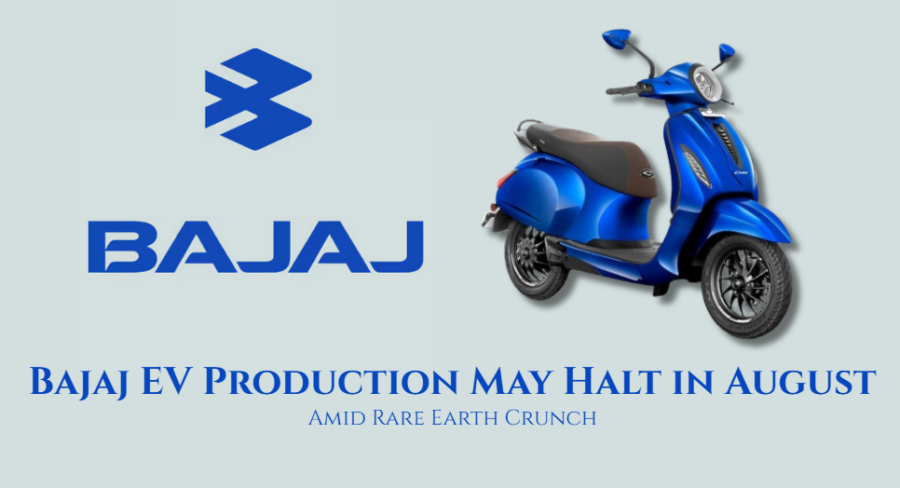4-Point Overview:
- Magnet Mayhem: Bajaj may pause EV production in August due to a severe shortage of rare earth magnets from China.
- Festive Jitters: The timing couldn’t be worse — this crisis hits right before the high-demand festive season.
- No Easy Solutions: Supply chain overhaul isn’t quick or cheap, and local alternatives are scarce.
- Policy Plea: Rajiv Bajaj calls for urgent government clarity and faster subsidy disbursements.
Introduction: Trouble in the Wires
Just when India’s electric two-wheeler space seemed to be picking up pace, Bajaj Auto — one of the most prominent names in the game — is staring at an unexpected pitstop. Come August, Bajaj might be forced to halt EV production altogether, thanks to a severe shortage of rare earth magnets, an essential component in EV motors. And it’s not just about production; this shortage has the potential to throw a wrench into the entire EV momentum.
The Real Problem: Where Did the Magnets Go?
Rare earth magnets are what make electric motors tick — without them, you simply don’t have an EV. And most of these magnets? Sourced from China.
But recently, China imposed strict export restrictions, limiting the supply of these crucial materials to companies across the globe. That decision has left companies like Bajaj scrambling. And with the popular Chetak EV in its portfolio, the scale of Bajaj’s operations means even a small disruption becomes a massive production bottleneck.
Rajiv Bajaj didn’t hold back. He publicly acknowledged that no magnets = no motors = no EVs. Plain and simple.
No Quick Fixes, No Plan B (Yet)
Switching suppliers isn’t as easy as it sounds. You can’t just plug in a new motor overnight.
- It involves redesigning hardware.
- Reworking software integration.
- Aligning with new regulatory approvals.
- And most importantly — time and money, both of which are in short supply.
And the timing? Couldn’t be worse. With festive season planning already underway, a slowdown in August could mean empty shelves in October, right when buyers line up for deliveries.
What Bajaj Is Asking For
Unlike some manufacturers who have approached the government for relaxations under the PLI scheme, Bajaj isn’t asking for favors.
Instead, Rajiv Bajaj is asking for clarity.
He wants real-time updates on policy changes, better forecasting support from the government, and — most critically — timely release of pending EV subsidies.
For instance, in Maharashtra, subsidy reimbursements have been delayed for almost two years, despite customers having already received the promised benefits. That’s not just a cash flow problem — it erodes trust.
This Isn’t Just a Bajaj Problem
The impact of this shortage will ripple beyond Bajaj:
- Small suppliers who built their capacity around EV parts may now face cancellations.
- Dealerships expecting festive push will see fewer deliveries.
- Buyers may have to wait longer or even switch to other brands.
This shows a bigger truth — India’s EV ecosystem is still fragile, too dependent on imports, and too vulnerable to international policies.
Why August?
August isn’t just another month on the calendar — it’s the calm before the festive storm in India’s auto market. Brands like Bajaj ramp up production now to ensure showrooms are stocked for big-ticket festivals like Navratri and Diwali. A halt in August means missing the most crucial sales window of the year, leading to delivery delays, unhappy customers, and missed revenue. For Bajaj, timing couldn’t be worse — this isn’t just a pause, it’s a potential blow to their entire festive strategy.
Summary Table
| Concern Area | Details |
|---|---|
| Core Issue | Rare earth magnet shortage from China |
| Bajaj’s Situation | EV production may pause in August 2025 |
| Key Product Affected | Bajaj Chetak and other upcoming EVs |
| Root Cause | China’s export curbs on heavy rare earth materials |
| Immediate Fixes | None feasible in short term |
| Festive Season Risk | Potential inventory shortages during peak demand months |
| Bajaj’s Ask | Policy clarity, real-time updates, subsidy clearance |
| Impact on Others | Suppliers, dealerships, and customers could all feel the crunch |
Conclusion: Time to Rethink the EV Playbook
This magnet crisis is more than a supply glitch — it’s a wake-up call. If India truly wants to lead in EVs, local sourcing, smarter policy timelines, and stronger government-manufacturer collaboration need to be top priority.
Because right now, it’s not just magnets Bajaj needs — it’s momentum.

